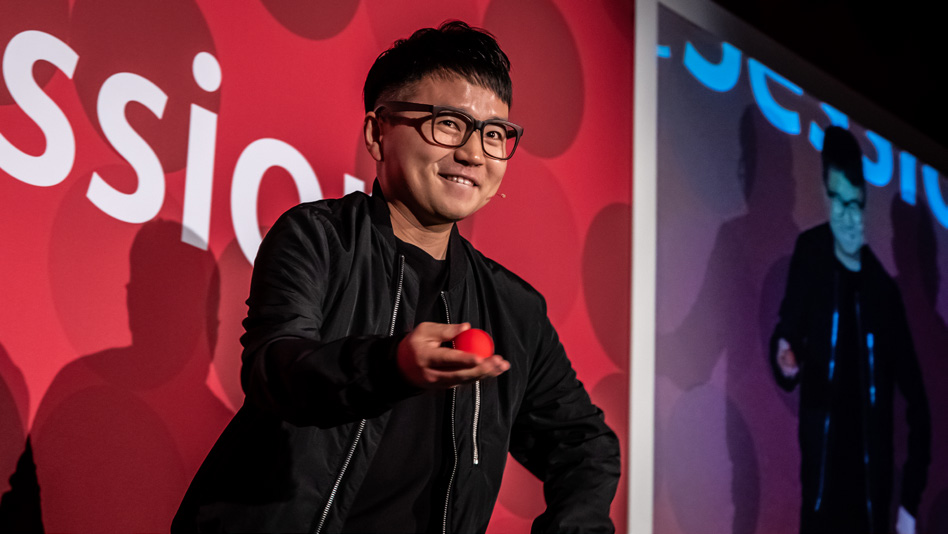
Questions by Vanish Magic Magazine
PHOTO BY VANISHING INC. AND SEAN EAST
MAGIC VIRTUOSO
Background & Early Magic Career
Can you tell us about your journey into magic? What first inspired you to become a magician? I first got into magic when a close friend showed me a French Drop. That simple trick fascinated me, and from that moment, I started learning magic by watching videos online and teaching myself. At the time, there was a magic boom in Korea, thanks to TV magicians (Charming Choi and E.G. Lee) and I happened to stumble into it by chance. As I practiced more, I began attending local magic clubs regularly, making friends who also shared a passion for magic. I learned from them and naturally developed magic as a hobby. Around that time, I had the opportunity to watch FISM performances and other competition videos, which completely changed my perspective on magic. Seeing those magician’s creativity made me admire them, and I started thinking about creating my own unique act. Since then, I have participated in various magic competitions in Korea, both big and small. In 2006, I won the Grand Prix at the Busan International Magic Festival, which led to my first invitation to perform abroad, at Ton Onosaka’s Hakone Convention in Japan. I was 20 years old then, and performing alongside famous magicians like Ali Bongo and meeting many magicians inspired me to seek more opportunities like this. During that period, I also had a chance to watch E.G. Lee’s magic concert. His performance showed me how magic could convey
"I’ve always believed that magic must connect with people. No matter how visual or original a trick is, it needs a clear purpose and strong delivery."
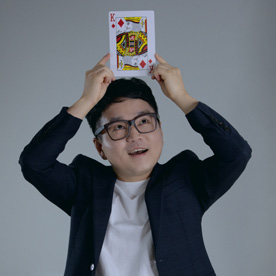
8
JULY | 2025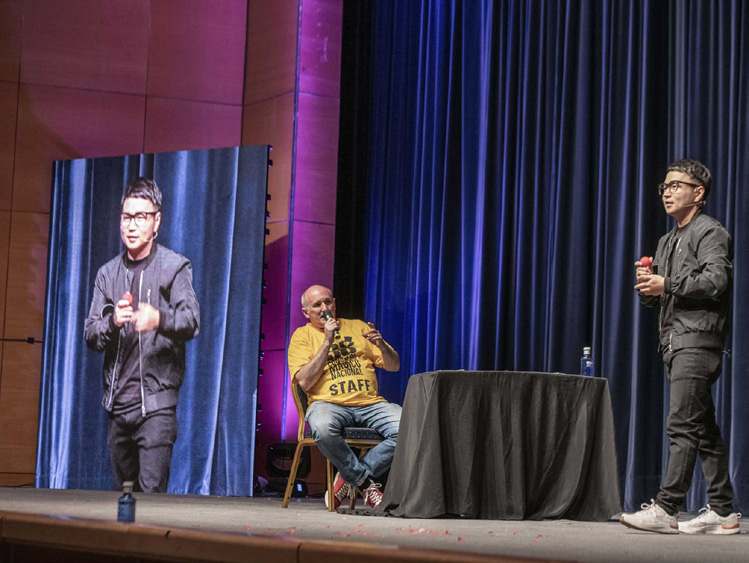
PHOTO BY MAGIA VALLADOLID
E.G. Lee’s magic performance showed me how magic could convey deep emotions and create meaningful experiences for an audience. That was a turning point for me ...
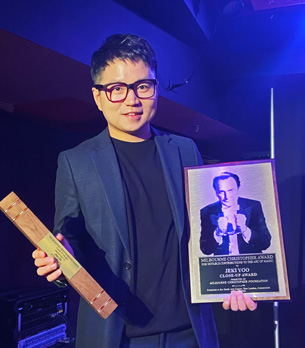
deep emotions and create meaningful experiences for an audience. That was a turning point for me, I made up my mind that I wanted to become a magician.
In 2008, a magic department was established in Busan, my hometown —only the second magic program in Korea at the time. I studied magic there for a year, training under Kim Hyun-soo, Casa Kim, Kim Won-il, Kim Chan-joo, and An Song-u (Yuji Yasuda). Imagine learning magic five days a week —it was an intense and immersive experience that gave me a broad and solid foundation.
As for my visual and original style, it was heavily shaped by the magicians of my generation. I started competing in magic contests at a young age, which made me almost obsessed with creating new magic. The pressure of competition pushed me to develop effects that were not just technically impressive but also visually striking. Over five to ten years, this creative drive became a defining part of who I am.
You have a very visual and unique style—who were your biggest influences in shaping your approach to magic? The magician who influenced me the most is Kim Hyun-soo. He loved classical magic and was skilled in stage, parlor, and close-up magic. He was my first mentor, and in my early twenties, I built my foundation under his guidance. Thanks to him, I developed the ability to perform in different styles. His versatility taught me that a magician should be adaptable, which became one of my core principles.
MILBOURNE CHRISTOPHER AWARD 2022However, I’ve always believed that magic must connect with people. No matter how visual or original a trick is, it needs a clear purpose and strong delivery. That balance—between innovation and meaningful performance—
9
JULY | 2025
Must See, incredibly talented magician! - Steve Harvey
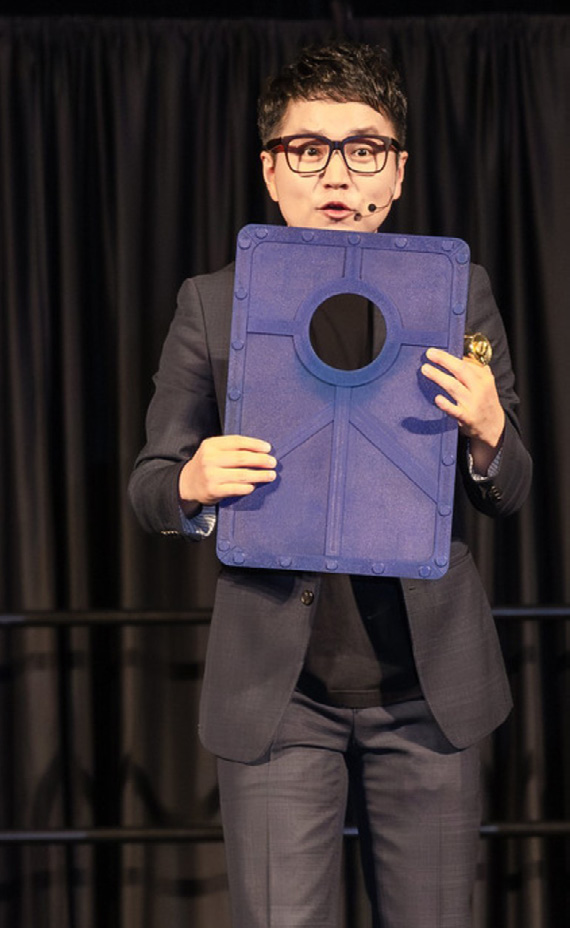
WITH STEVE HARVEY ON TELEVISION
comes from the lessons I learned from both my mentors and my own experience as a performer.
What was the magic scene like in South Korea when you were starting, and how did it shape your career? When I first started magic in 2002, South Korea’s magic scene was still in its early stages, gradually gaining momentum. Rising stars like Charming Choi and E.G. Lee were bringing magic into the public eye, and small magic clubs were forming in different cities. Online communities were becoming more active, allowing magicians to share ideas and connect, even if resources were still scarce. On television, internationally recognized magicians were starting to appear, and during holidays, networks would either invite foreign magicians to perform or purchase the rights to broadcast international magic shows.
Learning magic at that time was incredibly challenging. There were almost no structured lessons, very few books available, and almost no local mentors. The only way to learn was through foreign websites or by finding the occasional beginner’s magic book in a bookstore. As a teenager with no money, I couldn’t afford to buy tricks online, so I had to teach myself. I would rewatch performances frame by frame, analyzing every move and trying to recreate the effects through trial and error.
PHOTO BY UNIQUE SACRAMENTO STATE
But I loved the process. I would stay up all night practicing, experimenting, and questioning why certain magicians performed the way they did. Over time, I naturally started forming my own philosophy about magic. Looking back, I realize that if I had simply bought tricks instead of figuring them out on my own, I wouldn’t have developed the creative problem-solving skills that define my magic today.
Despite this growing exposure, magic wasn’t fully respected as an art form. Many people saw it as a low-tier form of entertainment, something trivial rather than something to be appreciated. When I performed, audiences were often more interested in figuring out the secret than experiencing the magic itself. Some dismissed it altogether, believing it wasn’t worth taking seriously.
Then, in 2006, a new wave of Korean magicians emerged. Manipulators like An Ha-Lim and Seol Hui Han introduced completely original styles
10
JULY | 2025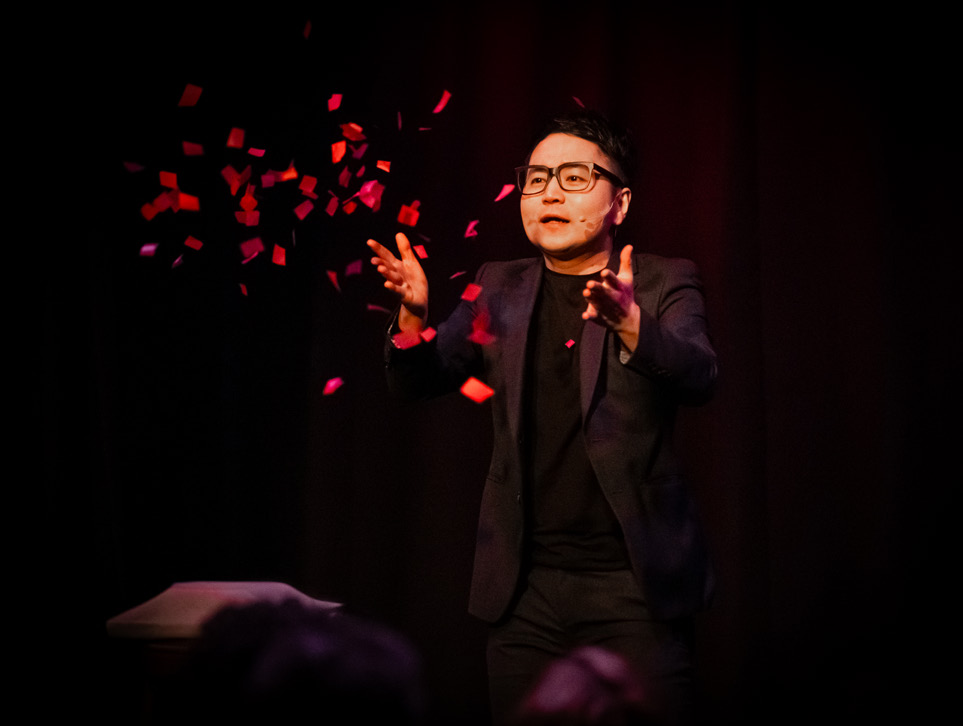
Jeki’s Handling of makes them appear to have life of their own. He received a standing ovation as soon as he finished his act. The audience reaction, throughout his act, was truly amazing.
- by Hyojung Kim - BUSAN ILBO
PHOTO BY MARK THOMAS
that had never been seen before. They won major international magic competitions and started performing overseas, gaining global recognition. Their success had a huge impact on the Korean magic community. Many young magicians, including myself, were inspired by their originality and dedication.
For me performing on the FISM stage. It had always been a dream of mine. When I first started magic, FISM felt like the ultimate goal—a place where the best magicians in the world competed."
As Korean magicians began making their mark on the world stage, the magic scene in Korea evolved rapidly. These changes showed me and others in my generation that if you could surprise the world with something truly new, incredible opportunities would open up. That realization shaped my journey as a magician, pushing me to explore my own creative path. Looking back, I think that was the moment when I truly started to define my own approach to magic.
place where the best magicians in the world competed. I knew that if I could perform there, it would mean I had reached a certain level.
I didn’t want to end my FISM journey on that note, so I worked harder and returned in 2012 in Blackpool. This time, I felt more prepared. I had refined my act, strengthened my performance , and built more confidence. When I finished my routine, the audience gave me a standing ovation. It was a surreal moment— one that felt like the result of years of persistence and growth.
I first competed in 2009 in Beijing. I had prepared for it for years, but when I stepped on stage, I was incredibly nervous. Even though I had practiced the act countless times, my execution wasn’t as strong as I had hoped. It was a learning experience—one that made me even more determined to improve.
That experience didn’t make me feel like I had "made it" in the sense of reaching a final destination, but it did feel like a milestone. It was proof that the effort I had put in was paying off. More than anything, it reminded me that success in magic isn’t about a single moment—it’s about continuously improving and pushing forward.
You’ve performed on major stages and TV shows worldwide —was there a moment when you felt like you had "made it" as a magician? For me, one of the biggest moments was performing on the FISM stage. It had always been a dream of mine. When I first started magic, FISM felt like the ultimate goal—a
11
JULY | 2025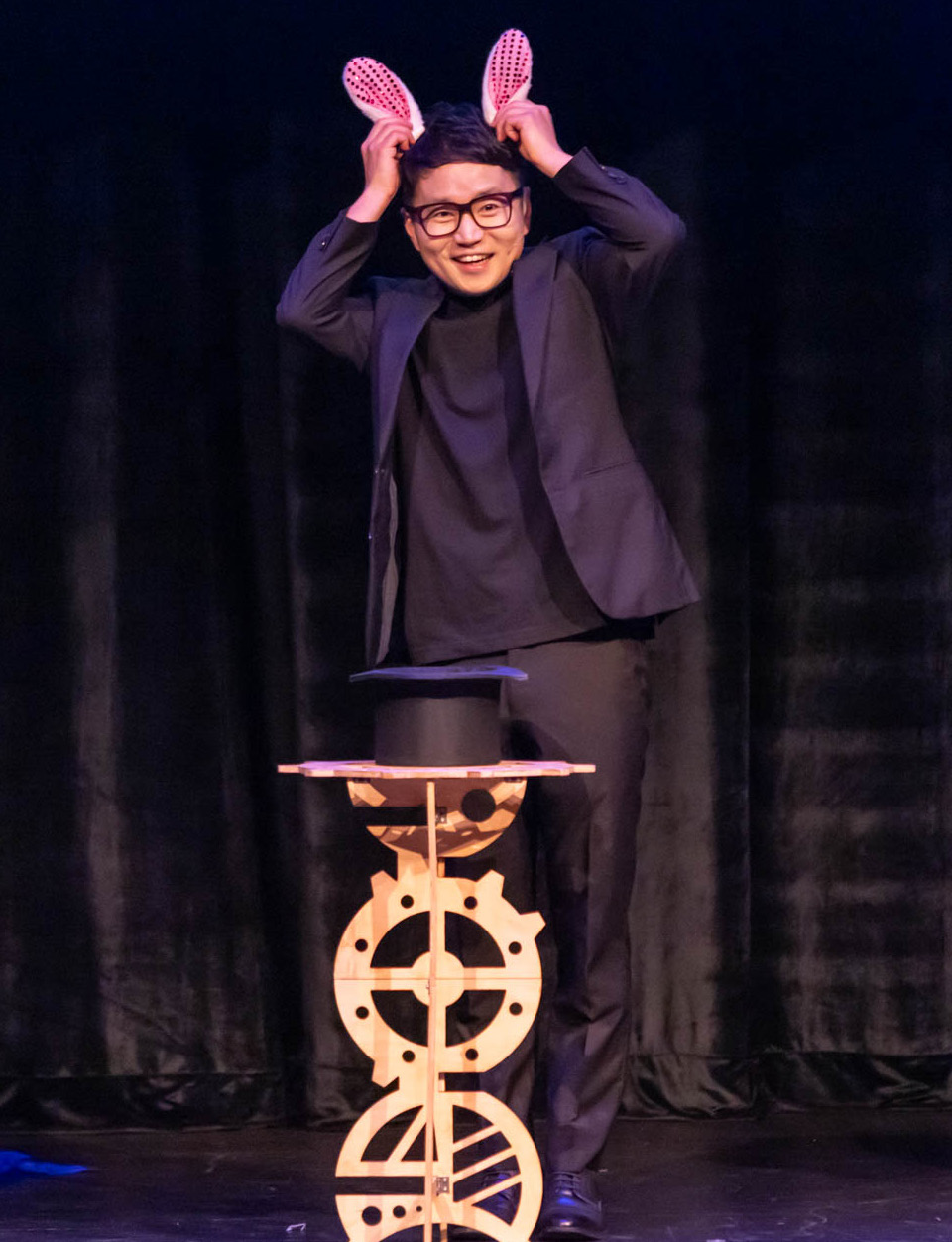
PHOTO BY BRADSHAW ARTS CENTER
12
JULY | 2025" When I have an idea, I don’t just settle for the first version—I revisit it, tweak it, and refine it until it truly works."
Creativity & Online Magic
Your online magic is incredibly visual and creative. How do you come up with ideas for new effects?
No one creates something extraordinary from the start. Some ideas come from tweaking existing concepts, while others are completely original. But in the end, creativity is all about continuous discovery, refinement, and having fun along the way.
But when the pandemic gave me unexpected free time, I finally had the opportunity to bring many of them to life.
When I first started sharing magic online during the pandemic, I quickly realized that coming up with new ideas consistently was just as important as performing them. At first, I had a handful of ideas written in my notebook, but I soon saw that if I posted daily, I’d run out of content in a week. That’s when I started thinking more intentionally about creativity.
In the beginning, I took magic too seriously, focusing too much on making it “artistic.” But that approach limited my possibilities. Once I allowed myself to be more playful and experimental, ideas started flowing endlessly. Keeping an open mind and being willing to try anything became the key to my creativity.
Do you approach creating online magic differently than live magic? If so, what are the key differences? The biggest difference lies in how the audience experiences the magic. In live performances, the audience sees everything unfold right in front of them, making it easier to create and maintain a sense of wonder. The direct interaction and real-time reactions add to the magic, making it feel more tangible and believable.
To keep up with a goal of posting 2–3 videos per week, I had to constantly search for inspiration. I looked through online platforms like Pinterest, studied artwork, and even walked through dollar stores, picking up random objects and imagining how they could be used in magic.
For me, inspiration comes from noticing what’s missing. Whether it’s a photograph, a street sign, a funny comment, or even an ordinary object that suddenly looks different, I let my thoughts fill in the gaps. When I have an idea, I don’t just settle for the first version—I revisit it, tweak it, and refine it until it truly works. I usually brainstorm 3 to 5 ideas at the same time. I start by working on the one that can be executed the fastest, practicing, developing , and filming it. Meanwhile, I keep thinking about the others, figuring out solutions as I go.
With online magic, however, everything is viewed through a screen, so maintaining that sense of mystery requires a different approach. To make the magic feel real, I often use a single-take shot, film the trick up close so viewers can experience the effect more intimately, or capture audience reactions alongside the trick to reinforce its authenticity. These technical choices help bridge the gap between the screen and reality, ensuring that the magic still feels impossible.
Actually, my creative mindset started long before that. Back in 2017, when I first immigrated, I spent nearly two years sitting in Starbucks for 10 hours a day, brainstorming magic ideas. I filled notebooks with hundreds of ideas that I never had the chance to try at the time.
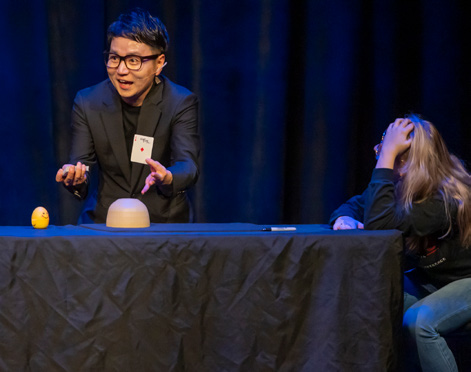
BRADSHAW ARTS CENTER
While both online and live magic may start with the same creative process, they develop in different ways. Live magic is about repetition and refinement—performing the same routine over and over, adjusting tiny details, and continuously improving its execution. This process is never truly finished, as there’s always room for growth.
Eventually, the second idea reaches the execution stage, and this cycle continues. If an idea doesn’t work out, I let it go and make space for new ones.
13
JULY | 2025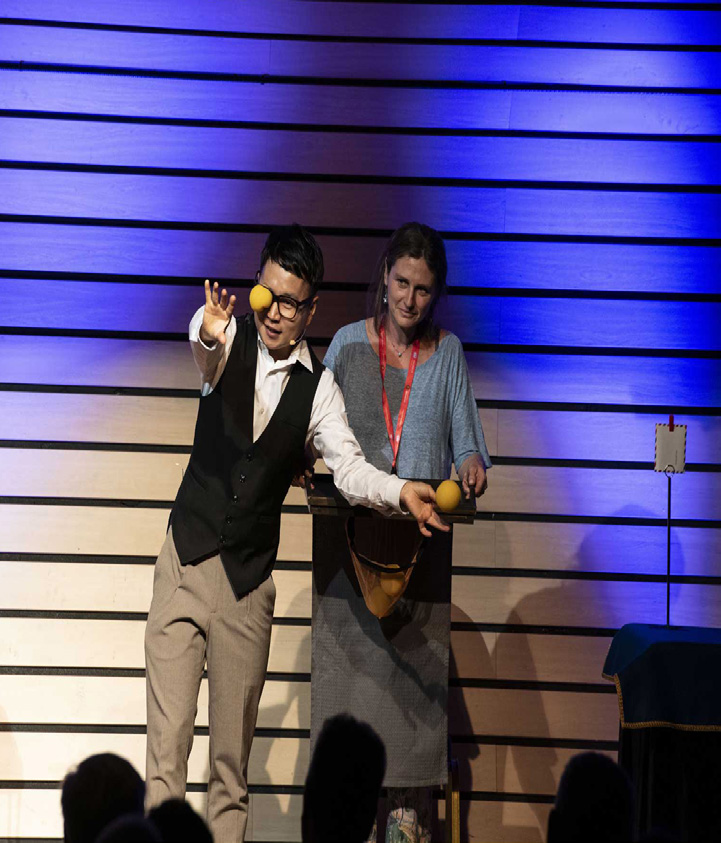
The act revolves around the art of complete costume changes which are so fast, you could miss it with the blink of an eye. - by Maise Duff/United KPop
Online magic, on the other hand, requires constant fresh content. Since new videos need to be created regularly, the execution is much faster and more lightweight. Instead of spending years refining a single piece, I focus on bringing ideas to life quickly, experimenting with different concepts, and adapting based on audience engagement.
PHOTO BY MAGIA VALLADOLID
Ultimately, both formats challenge me in unique ways. Live magic is about long-term mastery and connection with the audience, while online magic is about adaptability and creative exploration. Despite their differences, they both share the same goal—creating moments of astonishment that make people believe in the impossible.
This method helps me save time while still improving my routine.The key takeaway is that having a strong technical foundation allows for quick execution and greater adaptability. It’s like having a treasure chest filled with skills I’ve collected over my career, I can open it up and pull out whatever I need for a new routine.
What role does technology play in your magic, especially when designing effects for social media? That’s a great question! Technique acts as a catalyst. Having a strong foundation in sleight of hand allows me to quickly build routines and add storytelling elements. A few years ago, I visited Patrick Kun’s home to film a collaboration video, and he gave me a few props, including a gimmicked card that had the front of a playing card and the back designed to look like a Bicycle card box.
Many magicians struggle to stand out online — what advice would you give to those trying to build a following? I completely understand this challenge. There are a few key things to focus on, with consistency being the most important. Right now, competition is tougher than ever, making it harder to grow an audience . However, by consistently posting, identifying your strengths, and studying trends, you can find what works.
As soon as I saw it, I realized I could use my palming techniques to create a fun routine. I combined it with other sleights and developed a "card under box" sequence . At the end, I switched the card box for the gimmicked card, making the box transform into a single card while the box appeared from my hat.
The key is self-analysis, understanding what makes some videos perform well and continuously refining your approach. At the same time, don’t overanalyze your weaknesses to the point that you stop creating. Sometimes, post something fun, sometimes post something amazing, experiment with different styles.
I had this concept in mind, so I started practicing and filming simultaneously. My approach to content creation is to record while practicing, if I get a clean take, that becomes the final video. If I simply hit record and try to perform flawlessly, I often fail, and in some cases, I might spend an entire day without getting a usable take.
When I first started, I wanted everything to look perfect, so I hesitated and overthought everything. In the end, that left me with nothing to post. The
14
JULY | 2025If a magician isn’t concerned about viewership, this may not be an issue. But if they want to attract more viewers and gain followers online, they need to see things from the audience ’s perspective. Many magicians say they perform for the audience in live shows, yet when it comes to online content, they often focus only on showcasing their own skills rather than thinking about the viewer’s experience .
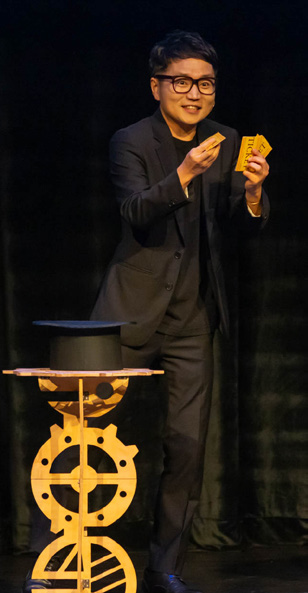
PHOTO JEKI YOO
They want high views, likes, and followers , but they shouldn’t post just to show off. I know this because I made the same mistake. If you want to be loved by your audience, you need to create content that they actually want to watch.
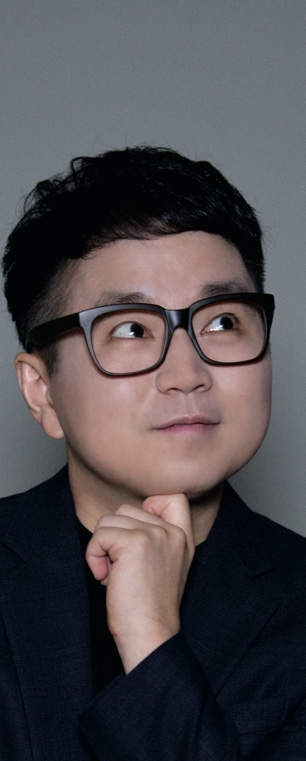
Now that I think about it, I realize this is a mistake I often make. I tend to only perform and share the magic that I personally like. But finding ways to make people want to watch it is the key to making them love what I love.
Do you think certain types of magic work better online than others? What effects or principles do you rely on most? Yes! Some types of magic definitely work better online due to the nature best advice I can give is to let go of perfectionism and experiment freely. Try different things, learn from the process, and grow through trial and error.
BRADSHAW ARTS CENTER
UNIQUE SACRAMENTO
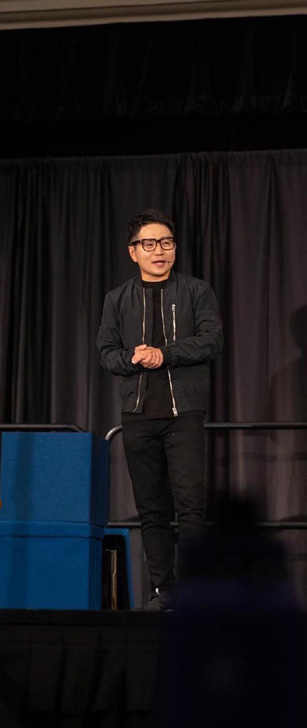
Advice for Magicians Wanting to Perform Online
What are the biggest mistakes magicians make when performing magic for an online audience? One of the biggest mistakes is focusing on themselves rather than the audience. Since viewers scroll quickly , it’s crucial to grab their attention instantly. However, many magicians start their videos by adjusting their hair, repositioning props on the table, or casually looking around before actually beginning the trick. Instead, it's better to have everything pre-set and jump straight into the effect. of the medium. Visual and fast-paced effects tend to perform well because they instantly capture attention. I rely heavily on quick transformations, color changes, and impossible visual moments—effects that create an immediate "wow" factor.
Magic that involves audience interaction , like mind reading or predictions, also works well online because it gives viewers a sense of real-time engagement. However, the biggest challenge with online magic is that audiences have shorter attention spans. Unlike live performances, where you can build suspense over time, online magic needs to hook the viewer within the first few seconds.
That’s why I think of online magic as a mini-show —if someone scrolls and sees my video, that moment is
15
JULY | 2025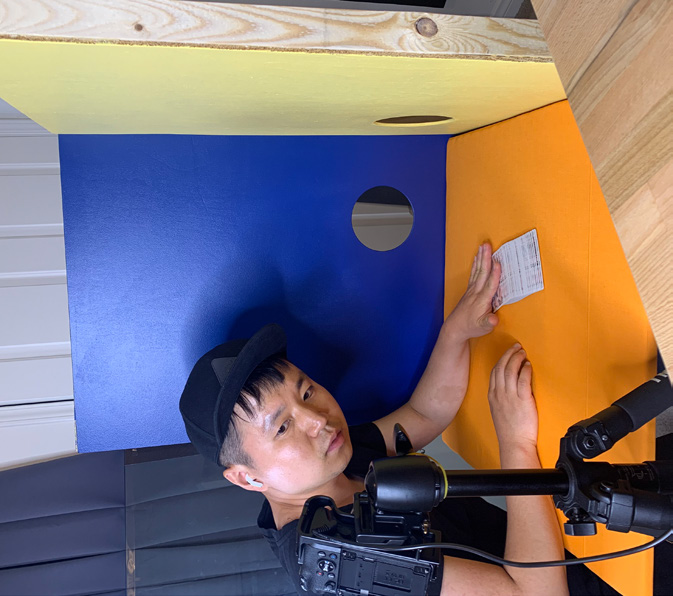
FILMING FOR SOCIAL MEDIA
"Nevermind quickchange , that’s the QUICKEST changing we’ve ever seen! "-Britain's Got Talent
magic under a glass table to make it look like I was revealing a trick’s secret—only for it to turn into an even bigger surprise. This approach kept things fresh for me while also appealing to viewers’ curiosity.
Since trends naturally attract more viewers , using popular keywords associated with trending videos makes it easier for my content to reach a wider audience. It’s not just about following trends blindly, but about strategically integrating them in a way that complements my magic. This way, my performances feel fresh, engaging, and more discoverable to people who might not have come across my magic otherwise.
my performance. Instead of setting up a trick slowly, I start with the most visually striking moment. For example, in a classic coin matrix, you typically place four coins under four cards before the magic happens. But online, this takes too long. Instead, I might start with the first coin already vanishing, immediately creating visual impact and curiosity.
By thinking in terms of concepts rather than just tricks, I can constantly reimagine magic in new ways. If you focus purely on effects, you may run out of ideas quickly. But if you create magic based on a theme or an engaging hook, the possibilities are endless.
In fact, some of the most viral magic content isn’t just performances—it’s the illusion of revealing a secret. Titles and keywords matter. Using phrases like “Revealing the Secret of This Trick” or “A Magician’s Perspective —Filming from Behind” instantly grab attention. Once I have the viewer’s interest, I use that opportunity to showcase the magic I actually want to share.
Since vertical videos are the norm, keeping the magic in the center of the frame is also crucial. If I use a table, I prefer a high one, or I lower my body so both my face and the magic stay in focus together. Studies show that people are naturally drawn to faces, and magic combined with direct engagement strengthens the connection with the audience.
Ultimately, online magic isn’t just about choosing the right trick—it’s about understanding how audiences watch and engage with content. Whether you prefer high-energy, fast-paced magic or a slower, more thoughtful approach, the key is to adjust your presentation to fit the platform. A well-crafted storytelling approach, combined with strong visuals and professional production, can be just as effective as quick, eye-catching magic.
But this is just one of the ways I approach online magic. I also analyze what makes viral videos trend —not just within magic, but across all types of content. By studying what elements make a video go viral , I can adapt those techniques to my own magic performances. Whether it’s a specific video format, editing style, or even a trending challenge or sound , incorporating these elements helps my videos gain momentum.
Magic is something we love, but to truly stand out, the magician—not just the trick— needs to be memorable. That’s why I remove unnecessary elements and keep my speech concise. Since English isn’t my first language, long scripts are harder to memorize for filming , so I naturally started cutting my speech down to the essentials. Even my catchphrase, “Oh My,” evolved this way—I originally said “Oh my gosh,” but it felt too long on camera, so I shortened it, and over time, it became my signature phrase.
By understanding social media and playing to your strengths , you can develop your own unique way to present magic online.
How do you balance creating magic for social media with keeping your live performances fresh and original? Balancing social media magic with keeping live performances fresh has been challenging
I also focus on themes and concepts rather than just effects. For example, I once filmed
16
JULY | 2025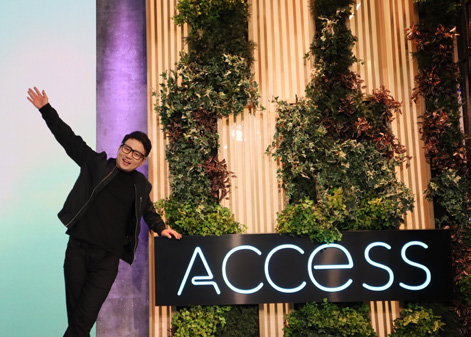
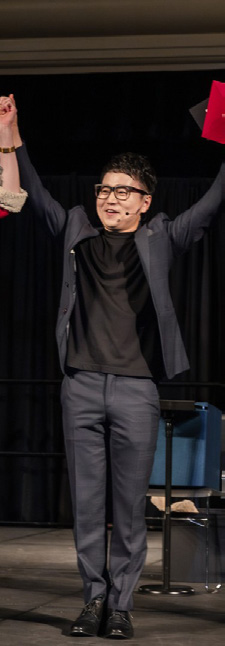
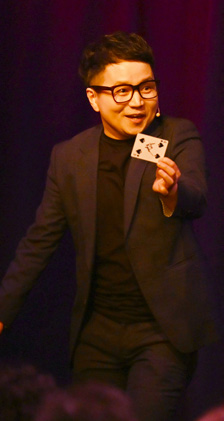
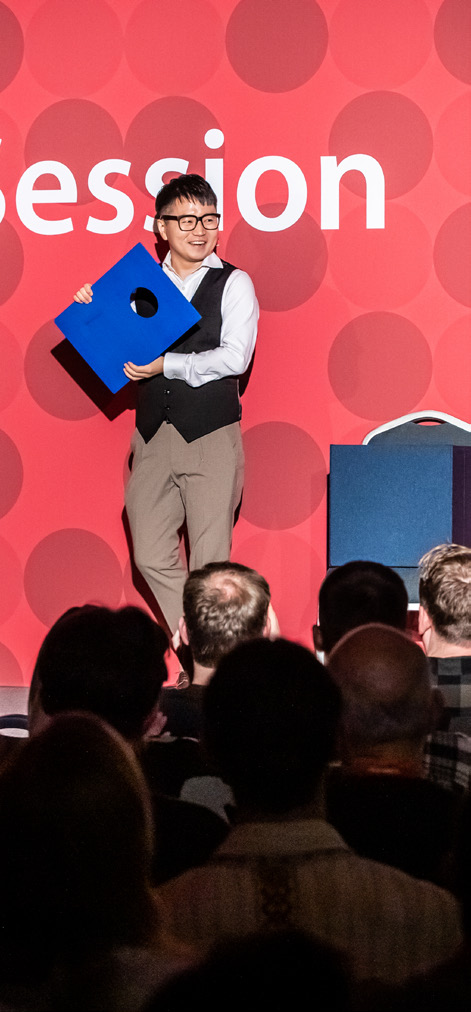
for me. In fact, handling both simultaneously was nearly impossible. After the pandemic, I focused entirely on creating content for social media, which allowed me to naturally accumulate ideas that could later be adapted for live performances.
Now, I approach the two as complementary rather than conflicting. Instead of trying to balance both at the same time, I shift my focus between them in different periods. Sometimes, I dedicate my time to filming new content, while other times, I focus entirely on refining my live performances. This way, I can fully commit to one without feeling stretched too thin.
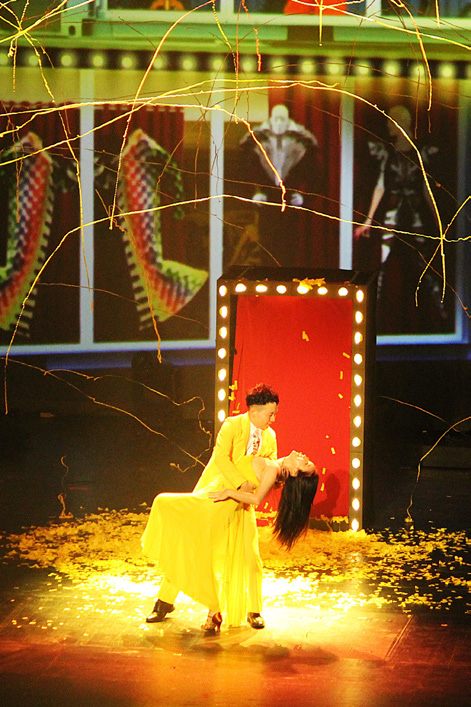
Interestingly, my time as a content creator has had a positive impact on my live performances . The process of constantly creating magic for social media pushed me to develop
PHOTO BY MÜNCHEN MUSIK
17
JULY | 2025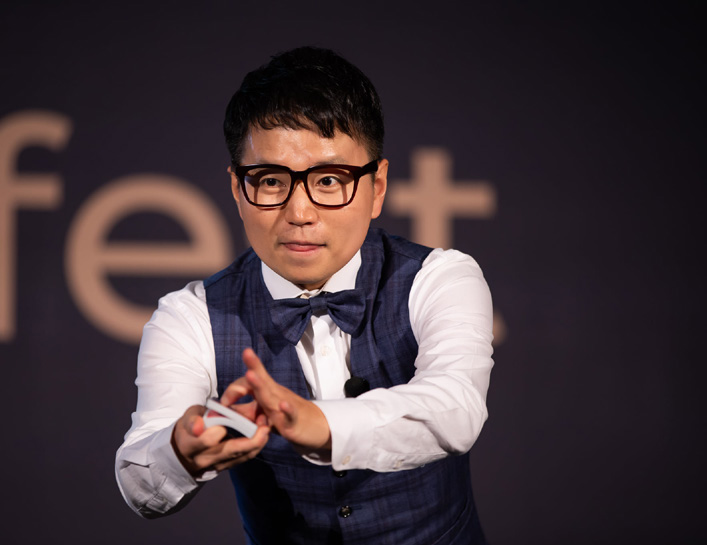
PHOTO BY VANISHING INC and refine new ideas, which I now explore in a more practical way for the stage. Likewise, when I focus on live shows, my experience in content creation allows me to effectively promote myself through video production.
Ultimately, content creation has opened many doors for me, leading to performances, lectures, and workshops around the world. Without it, I might not have had these opportunities. While balancing the two is difficult, they feed into each other in a way that keeps my magic evolving—both online and on stage.
Skeptics often leave comments questioning my methods, but I see that as an opportunity rather than a challenge. Instead of dismissing their doubts, I use them as a source of inspiration. For example, when someone questioned whether I was hiding cards in my lap, it pushed me to refine my trick by performing it on a glass table. Then, when another person commented on my black clothing, I performed the same trick in bright-colored shorts. This continuous cycle of skepticism and improvement has led to some of my best creations.
Many people assume online magic is just camera tricks— how do you handle skeptics and maintain credibility? Many people assume online magic is just camera tricks, and I understand why. But I don’t let that bother me because my foundation is built on real sleight of hand. I genuinely love practicing new techniques—not for any specific purpose, but simply because I enjoy the process of mastering them. This deep passion for sleight of hand is what makes my magic authentic.
Another key factor in maintaining credibility is variety. I don’t just post visual shock-magic—I balance it with comedic routines, storytelling acts, and pure sleight-of-hand performances. By showcasing a wide range of styles, I prevent my audience from fixating on doubts and instead keep their minds open to the creativity behind my magic.
At times, when I come up with a fresh and exciting idea that seems impossible in real life, I use the camera as a tool to bring it to life quickly. However, this doesn’t mean my magic relies solely on camera tricks. Many of these ideas eventually evolve into real, live performances. Over the years, I’ve developed ways to perform tricks on stage that initially started as camera-based illusions.
Ultimately, I don’t fight skepticism—I embrace it. It challenges me to improve, keeps me sharp, and pushes me to create stronger magic. Over time, consistently posting high-quality content and proving my skills have built trust with my audience and fellow magicians. My approach is simple: Let the magic speak for itself.
18
JULY | 2025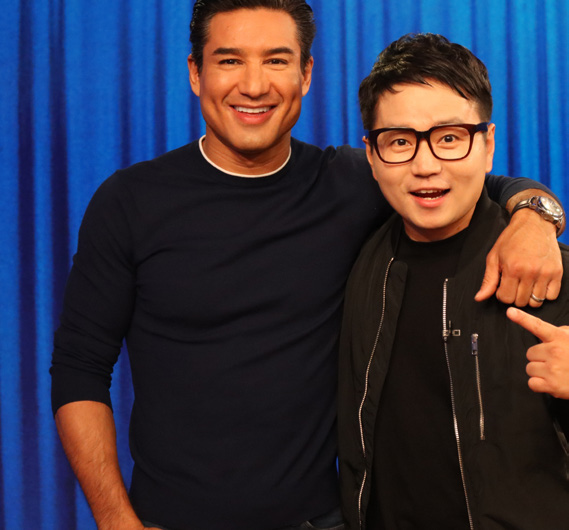
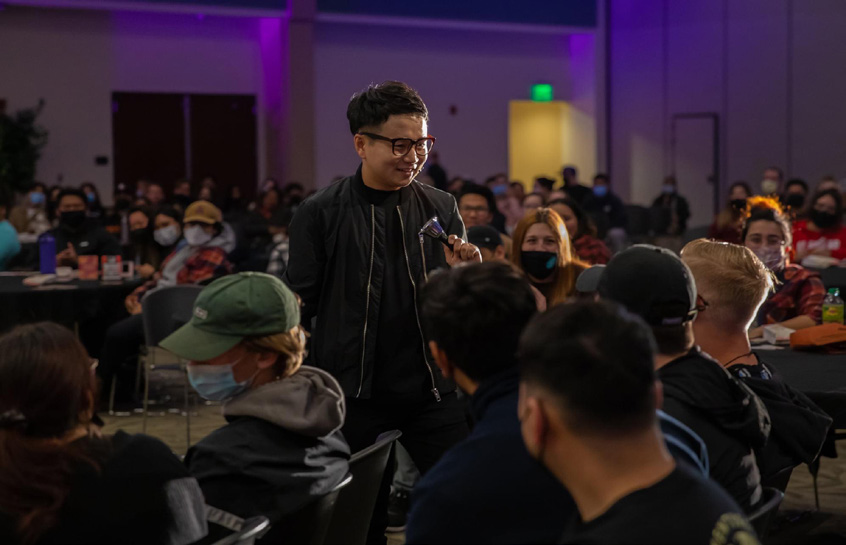
MARIO LOPEZ & JEKI
UNIQUE SACRAMENTO
"Whether online or on stage, my goal has always been the same—to share joy and create a memorable connection with my audience."
Other Interesting & Fun Questions:
Before immigrating to the U.S., I admired magicians like David Williamson, Jeff Hobson, and Mac King. I studied their performances and adapted their strengths in a way that fit my own personality. I also found Penn Jillette’s confident and charismatic way of speaking inspiring, so I practiced delivering my lines with a similar energy. Through trial and error, I gradually shaped my stage persona into something that felt authentic to me.
Rather than creating a stage persona intentionally from the beginning, mine developed naturally through experience, feedback, and inspiration. Whether online or on stage, my goal has always been the same—to share joy and create a memorable connection with my audience.
You’re known for your fun and charismatic performances. How do you develop your stage persona, and how does it translate to online content? At first, I tried to present myself as a serious and cool magician on stage. But when Ellie and I performed together before we got married, she kept telling me that a fun and lighthearted style suited me better. So, I started exploring that direction. In real life, I’m not the most outgoing person, but on stage, I wanted to express the version of myself that felt the most exciting and natural.
You’ve fooled Penn & Teller and impressed audiences worldwide —what’s been your most memorable reaction to one of your tricks? I think my glass table magic trick received the most memorable reaction. It was a turning point for me, both as a magician and as a content creator. At the time, the world was going through the pandemic, and like many others, I felt uncertain and isolated. That trick became my way of breaking through the gloom—not just for myself, but for the people watching.
My persona evolved even further online, especially during the pandemic. Everyone, including myself, was feeling down, so I wanted my videos to be uplifting and entertaining. I leaned into a more playful and exaggerated style, acting silly, making expressive reactions, and saying “ Oh My ”—which eventually became my signature catchphrase. Over time, this fun and high-energy style became second nature, seamlessly blending into both my social media content and live performances.
When I first posted it, the response was overwhelming. I still remember the flood
19
JULY | 2025What’s next for Jeki Yoo? Are there any exciting projects or performances coming up? Right now, I’m pouring my passion into refining my live performances. One of my biggest dreams since immigrating to the U.S. has been to create my own one-man show, and I’m actively working to make that a reality. Ultimately, I hope to tour across the U.S. with a show under my name or even perform on Broadway someday. My goal is to share my journey as an immigrant magician through my performances and connect with audiences on a deeper level.
of comments—people saying things like “This is real magic!” and “So clever!” The trick spread quickly, gaining attention from both magicians and casual viewers alike. Some even said they rewatched it multiple times, trying to figure it out.
What made this experience truly special for me was seeing magicians I respect recognize my work. Getting positive feedback from fellow magicians, including those I’ve admired for years, meant a lot.
In addition to that, I’ve been working on transforming some of the magic effects I originally created for social media—ones that seemed possible only on camera—into real, live performances. I’ve found ways to make them work in reality, and I’m excited to reveal them soon. Stay tuned!
But the most memorable part wasn’t just the initial reaction—it was how the trick evolved alongside the audience’s feedback. People would comment things like “I bet you can’t do this on a glass table.” That challenge led me to refine the trick further and perform it in different settings, pushing myself to make the illusion feel even more impossible.
Looking back, that trick didn’t just showcase my magic —it introduced me to the world. It shaped my identity as a performer and opened doors I never expected. More than anything, it showed me how engaging with the audience, even skeptics, could push my creativity forward. That experience continues to inspire how I approach magic today.
If you could collaborate with any magician (past or present) on a project, who would it be and why? If I had the chance to collaborate with any magician, past or present, it would be Tommy Wonder. He was my favorite magician growing up, and I’ve always admired not only his magic but also the thought process behind it. His creativity and attention to detail have been a huge source of inspiration for me. Even now, whenever I’m developing a new routine, his approach makes me pause and reflect on what truly matters in the final stage of creating magic.
Every movement, every detail had a purpose, making his performances feel effortless yet deeply thought out. The way he shaped his magic to be both theatrical and deceptive is something I deeply respect. If I had the chance to work with him, I would love to explore his creative process firsthand, learning how he refined ideas to perfection. Just imagining the insights he could share makes me wish such a collaboration were possible.
20
JULY | 2025